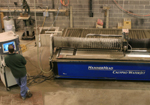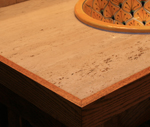|
How does a Waterjet work?

The cutter is commonly connected to a high-pressure water pump (Waterjet pump pressure can range from 40,000 psi (276 MPa) to 87,000 psi (600 MPa).) where the water is then ejected out of the nozzle, cutting through the material by bombarding it with the stream of high-speed water. Additives in the form of suspended grit or other abrasives, such as garnet and aluminum oxide, can assist in this process. Because the nature of the cutting stream can be easily modified, water jets can be used to cut materials as diverse as fish sticks and titanium. There are few materials that cannot be effectively cut with a water jet cutter; one of these is tempered glass, which shatters when cut, regardless of the cutting technology used. Certain ceramics are also resistant to water jet cutting. Water jet cuts are not typically limited by the thickness of the material, and are capable of cutting materials over twelve inches (30 cm) thick.

What are the benefits of using a Waterjet?
An important benefit of the water jet cutter is the ability to cut material without interfering with the material's inherent structure as there is no "heat affected zone" or HAZ. Minimizing the effects of heat allows metals to be cut without harming or changing intrinsic properties.

Water jet cutters are also capable of producing rather intricate cuts in material. The kerf, or width, of the cut can be changed by changing parts in the nozzle, as well as the type and size of abrasive. Typical abrasive cuts are made with a kerf in the range of 0.04" to 0.05" (1.016 to 1.27 mm), but can be as narrow as 0.02" (0.508 mm). Non-abrasive cuts are normally 0.007" to 0.013" (0.178 to 0.33 mm), but can be as small as 0.003" (0.0076 mm), which is approximately the size of a human hair. These small cutters can make very small detail possible in a wide range of applications.

|